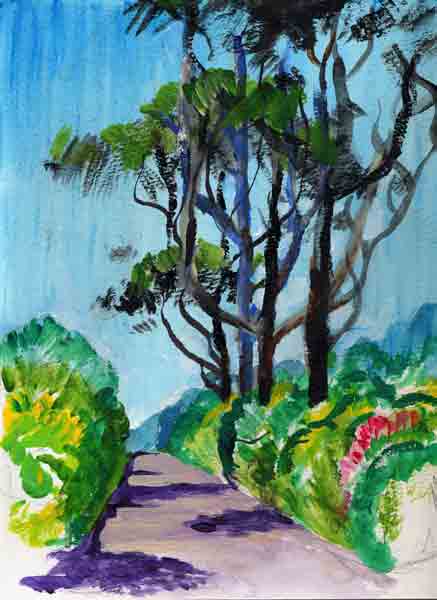|
Pound Street is broader than the other fork (Silver Street) and not quite so steep.
On the left, after only one tall building (occupied by Hotel One), opens a wide passage toward the Langmoor Garden and the sea.
Next to this gateway is a fine old-fashioned rambling hotel, the Alexandra, formerly Poulett House. It was just outside the town when built in 1735 by the first Earl Poulett. It is said that he ensconced his mother there, the Dowager Lady Poulett, to get her out of the way. Among those who later lived in the house were William Pinney, M.P. for Lyme during turbulent Victorian times; later again the Rev. Edward Peek; and it was converted into a hotel around 1900 by a group of entrepreneurs including one who rejoiced in the name of George Marie Stanislaus Guillaume Joseph Antoine Aloysius Louis Gasagne, Duc de Stackpoole.
On the street corner, between the path and the hotel's cobbled forecourt, is a small church-like building: it was indeed the Rev. Peek's chapel, before that the Pouletts' stable, and is now a store-room for the hotel.
You could go into the Alexandra and have tea on the lawn. It looks down through a semicircle of trees over the large Langmoor Garden (which once were oart of the house's territory) to the sea. In contemplating these gardens, remember John Gould.
Farther up Pound Street, Stile Lane opens on the left. It once was the way to the Cobb and now dwindles to a path down through the woods. There are several more hotels; one, the Buena Vista, was also attractive, and had its own secret path down into the Stile Lane path, but became one of the victims of the hotel-closing trend and was sold for apartments.
At the top of this stretch, on the left corner, is Belmont House, built as a seaside villa in 1777. In 1784 it was leased to Eleanor Coade: she invented and marketed the artificial stone known as Coade Stone, which was used in the 18th and 19th centuries for many kinds of architectural ornamentation, and is used on the front of this house. Dr. Bangay, an amateur astronomer, built the tower to the southwest as an observatory. The novelist John Fowles lived in the house from 1968 to his death in 2005. The garden, which in Fowles's time became a deep wood, runs down beside the Cobb Road.
The house is a Grade II listed building, and in 2006 “became a landmark,” that is, was taken into the care of the Landmark Trust. This body proposed in 2010 (proposal approved in 2011) that the house be restored to its original essence by removal of two wings added in the nineteenth century, one of which connected the house to the tower; the house to become a combination of museum and residence, sometimes open to the public and sometimes available for holiday rental by parties of up to eight people; the stable to be converted to an interpretive centre.
You reach the corner of the Cobb Road, steeply falling away to the left. Families are trotting down it with little spades and shrimp-nets and other beach toys in their hands, and you decide to go where they're going.
Or you're in a car, and must either keep on up this road, or park in the large Holmbush car park just past the turning. Maybe you're in your car because, having just moved to a house in or near Lyme, you have a trunkful of flattened cardboard boxes and other rubbish that you want to get rid of in the recycling hoppers that are at the upper right corner of the car park. You notice a virtuous cyclist who has arrived — up the steepness of Pound Street — with his four panniers fantastically full of towers of material to be recycled, and is stuffing it into the hoppers.
It happens, if the year is 2006, that a large part of the Holmbush car park is taken over as an equipment compound for the contractors who are working on the coastal defences. So some of the sets of steps down to the Cobb Road are blocked off. You ask one of the workmen: “Which way do I go to get to the Cobb?” He's new on the job, gazes around behind him and points toward a path that goes off a far right corner of the car park. You're a little distrustful, but the path leads invitingly away past four pines.

|
